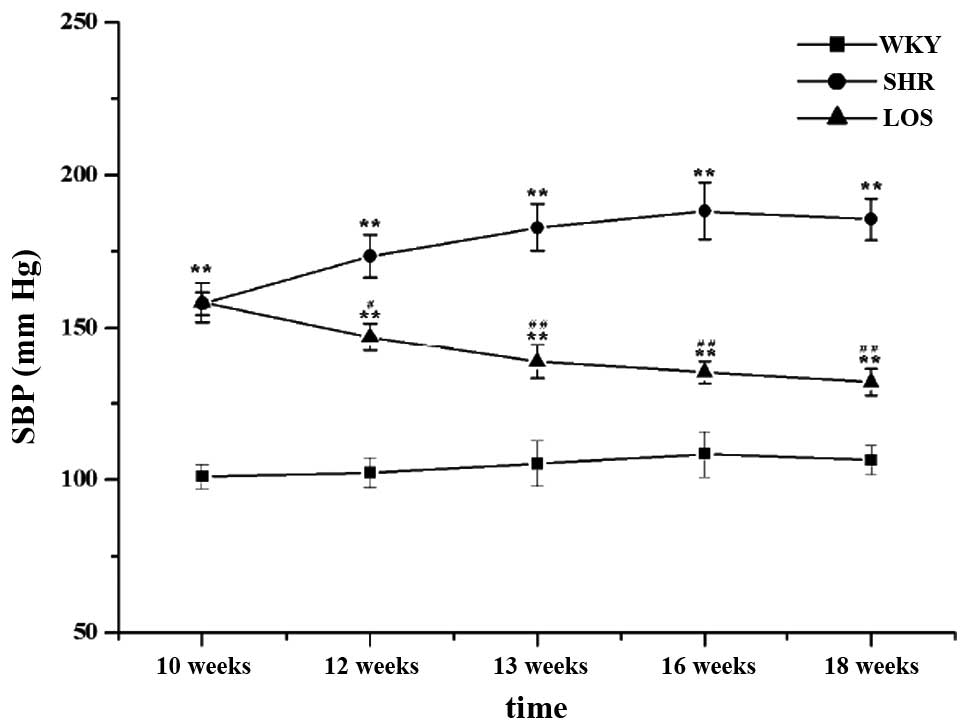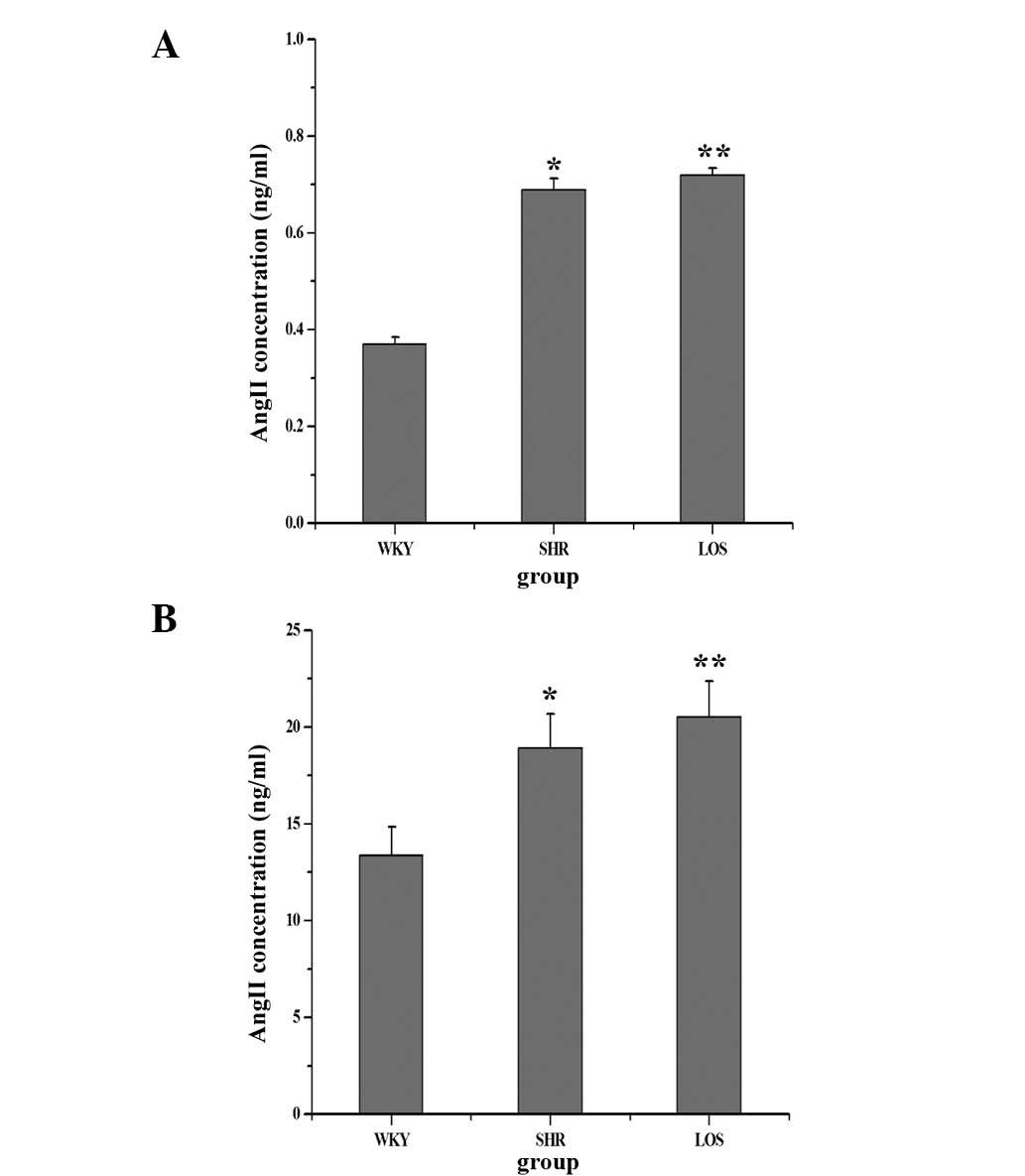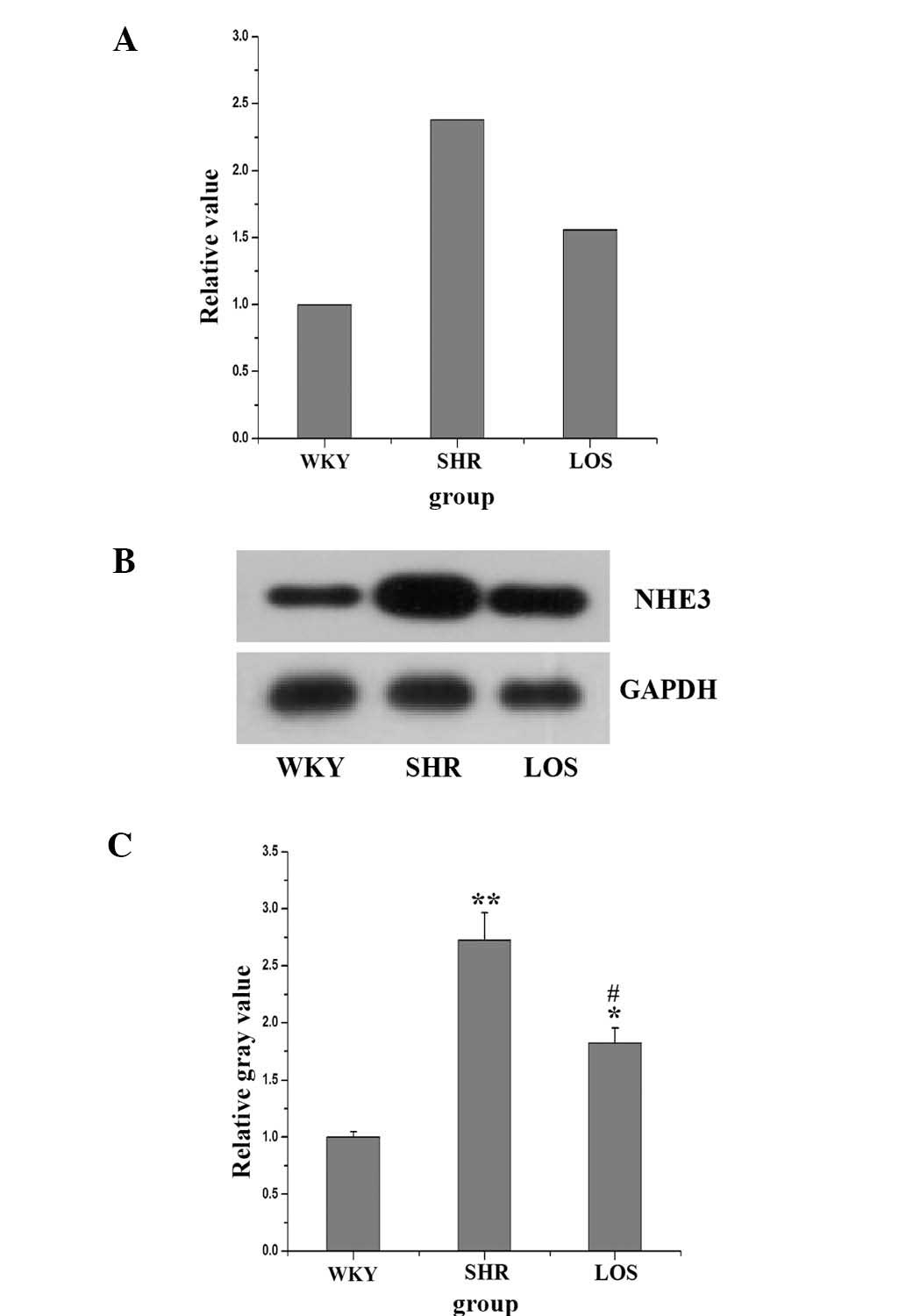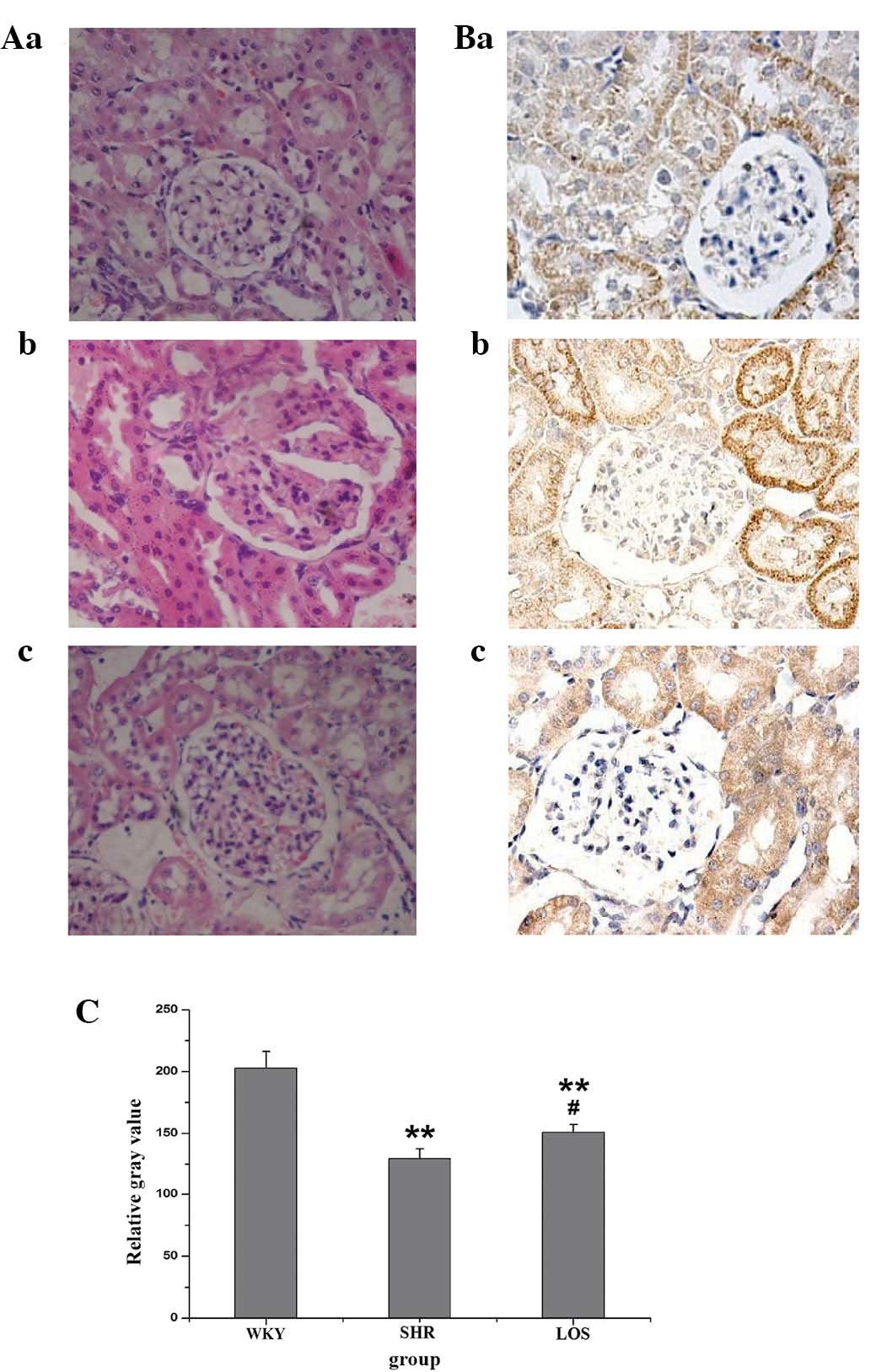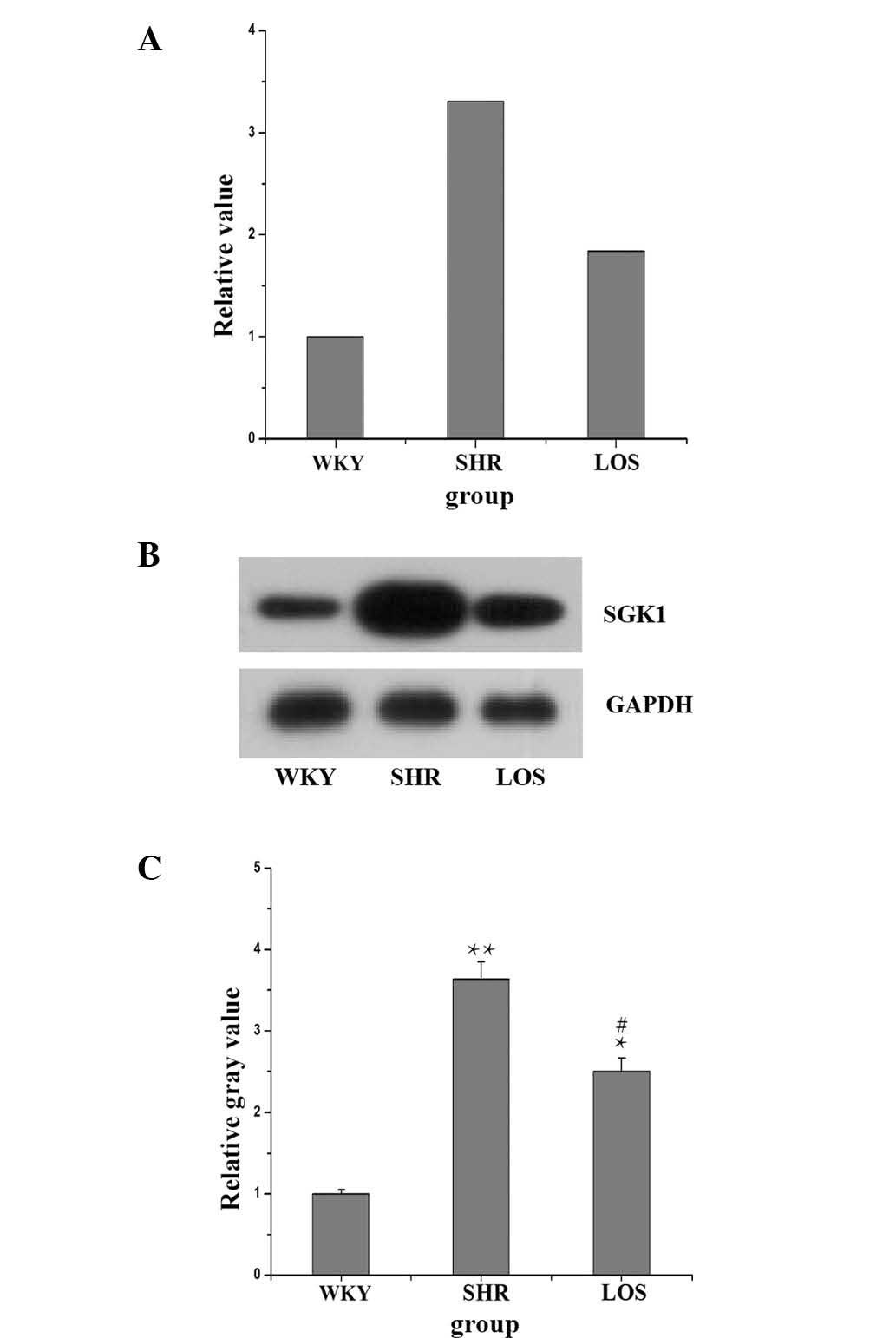Novel mechanism of intra‑renal angiotensin II-induced sodium/proton exchanger 3 expression by losartan in spontaneously hypertensive rats
- Authors:
- Published online on: August 14, 2014 https://doi.org/10.3892/mmr.2014.2492
- Pages: 2483-2488
Abstract
Introduction
Hypertension is recognized as one of the most frequent health concerns for the human population (1). There are numerous signaling pathways and feedback mechanisms that contribute to the process of hypertension and its associated diseases, including renal dysfunction and diabetes. The renin angiotensin system (RAS) has been demonstrated to be the main mediator in the pathogenesis of hypertension. RAS acts not only at a circulatory level but also at the tissue level, including the heart, kidney and brain, which are all of marked significance for the development of hypertension (2–4).
The principal peptide of the RAS is angiotensin II (Ang II), which acts by binding to one of the two major Ang II receptors AT1 and AT2 (5). In the kidney, Ang II, through the Ang II receptor type 1 (AT1 receptor), increases sodium retention and pressure within the glomeruli, which accelerates the progression of hypertension. The increased sodium retention by the proximal tubule is mediated by the Na+/H+ exchanger (NHE) (6). NHE is a ubiquitous transport system that is involved in the regulation of intracellular pH, cell volume, cell growth and proliferation, and transepithelial absorption of Na+, Cl− and HCO3− (7). Several isoforms of NHE have been identified in the kidney (8). With mRNA probes, NHE1 expression was identified at the basolateral membrane of renal epithelial cells. NHE-3, a tissue-specific isoform, is localized on the thick ascending limbs of the loop of Henle, the luminal membrane of proximal tubules and certain long thin descending limbs, as detected by low-stringency screening of cDNA libraries (9). NHE3 regulates bicarbonate absorption, salt, volume homeostasis and tubular protein expression. Renal NHE, particularly the NHE3 isoform, are essential for the maintenance of acid-base homeostasis. Both the expression and NHE activity are subject to complex regulation. In diabetic animal models, NHE3 expression is highly stimulated in the early phase, which is characterized by increased glomerular filtration rate. In conclusion, NHE has an important role in renal physiology and response to diabetes (10). Serum and glucocorticoid-inducible kinase 1 (SGK1) is expressed following exposure to a variety of hormones in kidney. SGK1 enhances the activity of a variety of carriers (NHE3, NHE1, SGLT1) and ion channels (renal outer medullary potassium channel, potassium voltage-gated channel subfamily E member 1/subfamily Q member 1, metabotropic glutamate receptor 6 and cystic fibrosis transmembrane conductance regulator). SGK1 contributes to Na+ retention and K+ elimination in the kidney. Therefore, SGK1 may participate in the pathogenesis of hypertension (11,12).
Clinically, blockade of the RAS is the prominent therapeutic strategy for the treatment of hypertension. The administration of angiotensin-converting enzyme inhibitors and Ang II receptor blockers are widely used in the treatment of hypertension (13). Losartan is a selective and competitive antagonist for the AT1 receptor. Currently, losartan is a highly popular antihypertensive agent with well-recognized clinical efficacy supported by large-scale clinical studies. However, the molecular mechanisms underlying the beneficial effects of losartan remain elusive.
The present study examined the expression of renal sodium/proton exchangers, particularly NHE3, affected by activated the RAS of renal tissue, in spontaneously hypertensive rats and aimed to elucidate the molecular pharmacodynamic mechanism of losartan.
Materials and methods
Subjects
A total of 12 spontaneously hypertensive rats and six Wistar-kyoto rats (WKY; male or female) aged 10 weeks, weighing 150 g from Vital River Laboratories Co., Ltd. (Beijing, China) were enrolled in the study. The spontaneously hypertensive rats were randomly divided into two groups: The SHR group (saline, six animals); the LOS group (losartan-treated, six animals). The rats were housed under conditions of constant temperature (24°C) and humidity (60%), exposed to a 12-h light/dark cycle, and provided tap water to drink, as well as SPF level standard rat feed. The experimental design was approved by the Institutional Ethics Committee of the Institute of Zunyi Medical College (Zhuhai, Guangdong, China).
Reagents
Losartan was purchased from Merck USA (Whitehouse Station, NJ, USA). Monoclonal antibody NHE3, monoclonal antibody SGK1 and immunohistochemical staining avidin-biotin-peroxidase complex (ABC) kit were purchased Santa Cruz Biotechnology, Inc. (Santa Cruz, CA, USA). The First Strand cDNA Synthesis kit and 2× AllinOneTM Q-PCR Mix were purchased from GeneCopoeia (Guangzhou, China), and the Angiotensin II radioimmunoassay kit was purchased from HTA Co. Ltd. (Beijing, China).
Blood pressure (BP) measurement
The BP was measured by the indirect tail cuff method, using an RM-6240 multi-channel physiological signal acquisition and processing system (Chengdu Instrument Factory, Sichuan, China). The measurements were performed while the rats were maintained in a temperature-regulated holder. The mean of three consecutive readings was used for BP determination.
Immunoradiometric detected of Ang II
An immunoradiometric method was utilized for the detection of plasma and renal Ang II by a radioimmunoassay kit according to the manufacturer’s instructions (HTA Co. Ltd., Beijing, China).
Immunohistochemical demonstration of NHE3 in kidney tissue
The kidney tissues were fixed for 12–24 h in 4% paraformaldehyde and following dehydration, were embedded in paraffin. The tissues were cut into 5-μm thick sections, which were then mounted onto glass slides, and following deparaffinization and hydration, were immunostained according to the manufacturer’s instructions. The sections were sequentially exposed to normal goat serum for 1 h and then to NHE3 antibody at a final dilution of 1:200 overnight at 4°C. Next, samples were labeled with the ABC complex diluted 1:200 for 30 min. The peroxidase label was revealed by reaction with stable diaminobenzidine. Photomicrographs were obtained with an Axiovert 200 inverted fluorescence microscope (Zeiss, Oberkochen, Germany). Six images of six fields of the histological sections were acquired. The samples were considered positive when >30% of the tissue components were immunohistochemically stained brown-yellow in the appropriate cellular compartment.
Reverse transcription-polymerase chain reaction
Total RNA was isolated from renal cortex using TRIzol (Invitrogen Life Technologies, Carlsbad, CA, USA) and the DNA was removed by the recombinant DNaseI. For qPCR, cDNA was prepared from 1 μg total RNA, using reverse transcriptase from the First Strand cDNA Synthesis kit in accordance with the manufacturer’s instructions. All PCRs were conducted using the 2× AllinOneTM Q-PCR Mix, and cycling parameters 95°C, 15 sec; 60°C, 15 sec; and 72°C, 20 sec for 39 cycles, with primers designed against the following mouse sequences:
Quantification of NHE3 and SGK1 protein by western blot analysis
The whole tissue lysates were separated on an 8% polyacrylamide gel. The proteins were transferred to a polyvinylidene difluoride membrane. The membranes were blocked with 10% skimmed milk in Tris-buffered saline-Tween-20 (TBST) for 1 h, and then probed with primary antibodies diluted in 5% milk in TBST overnight at 4°C. The membranes were washed three times with TBST and then incubated with secondary antibodies at room temperature for 1 h and developed using BeyoECL Plus kit (Beyotime Institute of Biotechnology, Jiangsu, China).
Results
Effect of losartan on the BP
The baseline BP in the spontaneously hypertensive rats was significantly higher than that in the WKY rats at ten weeks (Fig. 1). Treatment with losartan attenuated BP compared with the SHR group following two weeks, and the tendency of the BP remained attenuate with continuous losartan treatment in a time-dependent manner following eight weeks. There was a significant difference between the SHR and the LOS groups, but the blood pressure was still higher in the WKY group.
Effect of losartan on Ang II in the plasma and renal tissue
In the present study, the concentration of Ang II in plasma and renal tissue was examined in order to confirm that in hypertension, both at circulatory and tissue levels, the RAS was activated. As the results demonstrate in Fig. 2, the levels of Ang II in the SHR and LOS groups were significantly higher than those in the WKY group, not only in plasma (Fig. 2A) but also in renal tissues (Fig. 2B). However, following losartan treatment for eight weeks, the concentration of Ang II in plasma and renal tissue exhibited no significant difference between the SHR and LOS groups, but remained markedly higher than that in the WKY group. Therefore, the RAS at the circulatory and tissue levels was activated in the hypertension and losartan groups, while the antagonist of the AT1 receptor did not decrease the concentration of Ang II in the plasma and renal tissue.
NHE3 mRNA and protein expression
Previously, studies have demonstrated that Ang II increased NHE3 in human proximal tubular cells (PTCs) (14,15). To investigate the effect of Ang II on NHE3 in renal tissue of hypertension-associated renal dysfunction, the mRNA and protein expression of NHE3 was examined. The mRNA expression is revealed in Fig. 3A. In the SHR and LOS groups, the relative expression increased to 2.38 and 1.56, respectively, as compared with that in the WKY group, and losartan was able to reduce NHE3 expression. Meanwhile, the protein expression of NHE3, as revealed in Fig. 3B, was significantly increased in the SHR group, compared with that in the WKY group. Furthermore, following eight weeks of losartan treatment, the mRNA expression levels of NHE3 were decreased.
Effect of losartan on histopathology and NHE3 expression in renal tissue
The renal tissue was stained using traditional hematoxylin and eosin methods. Fig. 4A reveals the significant morphological changes in renal tissue that were observed, including glomerular dilatation and detachment of basement membrane from glomerulus, in the SHR group as compared with the WKY group. The damage in the renal tissue was ameliorated by treatment with losartan. Representative immunohistochemistry (IHC) images of NHE3 in the renal tissue are demonstrated in Fig. 4B. NHE3 staining was detected predominantly in the PTCs in the WKY group. Intense staining was noted in the brush borders and thick ascending limbs of the loop of Henle, except for the PTCs in the SHR group. These effects were weakened by losartan treatment. The quantified immunostaining intensities of NHE3 are revealed in (Fig. 4C).
SGK1 mRNA and protein expression
The effect of Ang II, via the AT1 receptor, on the mRNA and protein expression of NHE3 was examined, but the mechanism underlying this effect remained elusive. Previously, Stevens et al (16) confirmed that the Ang II-induced increase in the NHE3 expression was mediated through SGK1 in human renal PTCs of diabetes mellitus. It was therefore considered that Ang II may regulate NHE3 through an SGK1-dependent mechanism in hypertension-associated renal dysfunction (17). The present study investigated the mRNA and protein expression of SGK1 in renal tissue. The data (Fig. 5) demonstrated that the mRNA expression of SGK1 in the SHR and LOS groups was increased to 3.31 and 1.84 compared with that in the WKY group. Furthermore, the protein expression in the SHR and LOS groups was higher than in the WKY group. However, it was demonstrated that losartan treatment was able to significantly decrease the expression of SGK1.
Discussion
At present, hypertension affects ~1 billion individuals worldwide, and therefore, it is highly important to investigate the molecular mechanisms underlying the pathogenesis of hypertension and the activities of anti-hypertensive drugs. Numerous different factors contribute to the development of hypertension, including the RAS, which has an important role in the regulation and progression of hypertension. The major therapeutic strategies for the clinical treatment of hypertension are angiotensin-converting enzyme inhibitors and Ang II receptor blockers. Losartan is widely used in the clinic and is a typical representative Ang II receptor blocker, but the molecular mechanism underlying its effects have remained elusive.
The rats of the SHR and WKY groups have the same genetic background and used in the present study. In the present study, it was identified that the baseline BP of spontaneously hypertensive rats was reduced significantly by losartan following administration via intragastric injection over two weeks, and the BP continued to decline after this time-point. This demonstrated that losartan was effective in reducing the hallmarks of hypertension, which is consistent with the results of other studies (18–20). Next, it was confirmed that the circulatory and tissue levels of Ang II in the SHR group were higher than those in the WKY group, while Ang II levels in the LOS group were even higher than those in the SHR group. It was considered that losartan may exert its effects by increasing Ang II compensation.
The intra-renal RAS and the effects of RAS blockade on lead-induced nephropathy in hypertension were also examined. It has been demonstrated in PTCs of diabetes that Ang II alone at renal concentrations stimulates NHE3 mRNA and protein expression, which is mediated by SGK1, as reflected by increased Na+ reabsorption (16,21,22). This reveals an important role for the intra-renal Ang II-NHE3-SGK1 pathway in regulating Na+ uptake. Therefore, whether blocking of the intra-renal Ang II by losartan in hypertension may also affect this pathway was of particular interest in the present study.
Therefore, using qPCR and western blot analysis, it was possible to detect the mRNA and protein expression of NHE3 and SGK1 in renal tissue and demonstrate that both of them were upregulated in the SHR group compared with the WKY group. It was also identified that losartan reduced the mRNA and protein expression of NHE3 and SGK1. Furthermore, the histopathology and IHC determination of NHE3 in the renal tissue revealed that hypertension-associated nephropathy was reduced by losartan in the SHR group. In conclusion, in the present study revealed that the intra-renal RAS and Ang II-NHE3-SGK1 pathway were activated in renal tissue under hypertension, and that losartan reduced the hypertensive effect in the SHR group effectively via this pathway. The present study provided evidence for a new pharmacodynamic mechanism of action of losartan in the treatment of hypertension.
Acknowledgements
This study was funded by grants from the Natural Science Foundation (grant no. 31160214).
Abbreviations:
|
SHR |
spontaneously hypertensive rats |
|
WKY |
Wistar kyoto rats |
|
lOS |
Losartan |
|
Ang II |
angiotensin II |
|
BP |
blood pressure |
|
RAS |
renin angiotensin system |
|
NHE3 |
sodium/proton exchanger 3 |
|
SGK1 |
serum and glucocorticoid inducible kinase 1 |
References
|
Gu D, Reynolds K, Wu X, et al: Prevalence, awareness, treatment, and control of hypertension in China. Hypertension. 40:920–927. 2002. View Article : Google Scholar : PubMed/NCBI | |
|
Griendling KK, Murphy T and Alexander RW: Molecular biology of the renin-angiotensin system. Circulation. 87:1816–1828. 1993. View Article : Google Scholar | |
|
Peach MJ: Renin-angiotensin system: biochemistry and mechanisms of action. Physiol Rev. 57:313–370. 1977.PubMed/NCBI | |
|
Kobori H, Nangaku M, Navar LG and Nishiyama A: The intrarenal renin-angiotensin system: from physiology to the pathobiology of hypertension and kidney disease. Pharmacol Rev. 59:251–287. 2007. View Article : Google Scholar : PubMed/NCBI | |
|
Paul M, Mehr AP and Kreutz R: Physiology of local renin-angiotensin systems. Physiological Reviews. 86:747–803. 2006. View Article : Google Scholar : PubMed/NCBI | |
|
Biemesderfer D, Pizzonia J, Abu-Alfa A, et al: NHE3: a Na+/H+ exchanger isoform of renal brush border. Am J Physiol. 265:F736–F742. 1993.PubMed/NCBI | |
|
Malo ME and Fliegel L: Physiological role and regulation of the Na+/H+ exchanger. Can J Physiol Pharmacol. 84:1081–1095. 2006. View Article : Google Scholar : PubMed/NCBI | |
|
Orlowski J and Grinstein S: Diversity of the mammalian sodium/proton exchanger SLC9 gene family. Pfluegers Archiv. 447:549–565. 2004. View Article : Google Scholar : PubMed/NCBI | |
|
Amemiya M, Loffing J, Lötscher M, et al: Expression of NHE-3 in the apical membrane of rat renal proximal tubule and thick ascending limb. Kidney Int. 48:1206–1215. 1995. View Article : Google Scholar : PubMed/NCBI | |
|
Khan I, Batinic-Haberle I and Benov LT: Effect of potent redox-modulating manganese porphyrin, MnTM-2-PyP, on the Na+/H+ exchangers NHE-1 and NHE-3 in the diabetic rat. Redox Rep. 14:236–242. 2009. View Article : Google Scholar : PubMed/NCBI | |
|
Pao AC: SGK regulation of renal sodium transport. Curr Opin Nephrol Hypertens. 21:534–540. 2012. View Article : Google Scholar : PubMed/NCBI | |
|
Lang F, Huang DY and Vallon V: SGK, renal function and hypertension. J Nephrol. 23(Suppl 16): S124–S129. 2010.PubMed/NCBI | |
|
Smith DH: Comparison of angiotensin II type 1 receptor antagonists in the treatment of essential hypertension. Drugs. 68:1207–1225. 2008. View Article : Google Scholar : PubMed/NCBI | |
|
Xu L, Dixit MP, Nullmeyer KD, et al: Regulation of Na+/H+ exchanger-NHE3 by angiotensin-II in OKP cells. Biochimica et Biochim Biophys Acta. 1758:519–526. 2006. | |
|
Moe OW: Acute regulation of proximal tubule apical membrane Na/H exchanger NHE-3: role of phosphorylation, protein trafficking, and regulatory factors. J Am Soc Nephrol. 10:2412–2425. 1999.PubMed/NCBI | |
|
Stevens VA, Saad S, Poronnik P, et al: The role of SGK-1 in angiotensin II-mediated sodium reabsorption in human proximal tubular cells. Nephrol Dial Transplant. 23:1834–1843. 2008. View Article : Google Scholar : PubMed/NCBI | |
|
Wang D, Sun H, Lang F and Yun CC: Activation of NHE3 by dexamethasone requires phosphorylation of NHE3 at Ser663 by SGK1. Am J Physiol Cell Physiol. 289:C802–C810. 2005. View Article : Google Scholar : PubMed/NCBI | |
|
Lu D, Raizada MK, Iyer S, et al: Losartan versus gene therapy chronic control of high blood pressure in spontaneously hypertensive rats. Hypertension. 30:363–370. 1997. View Article : Google Scholar : PubMed/NCBI | |
|
Baumann M, Janssen B, Rob Hermans J, et al: Renal medullary effects of transient prehypertensive treatment in young spontaneously hypertensive rats. Acta Physiologica (Oxf). 196:231–237. 2009. View Article : Google Scholar : PubMed/NCBI | |
|
Koprdova R, Cebova M and Kristek F: Long-term effect of losartan administration on blood pressure, heart and structure of coronary artery of young spontaneously hypertensive rats. Physiol Res. 58:327–325. 2009.PubMed/NCBI | |
|
Kaunisto KM and Rajaniemi HJ: Expression and localization of the Na+/H+ exchanger isoform NHE3 in the rat efferent ducts. J Androl. 23:237–241. 2002.PubMed/NCBI | |
|
Karim Z, Gérard B, Bakouh N, et al: NHERF1 mutations and responsiveness of renal parathyroid hormone. N Engl J Med. 359:1128–1135. 2008. View Article : Google Scholar : PubMed/NCBI |



